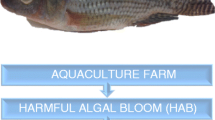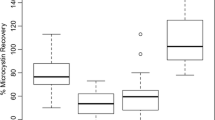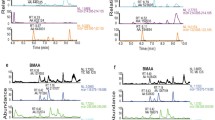Abstract
Until recently, exposure pathways of concern for cyanotoxins have focused on recreational exposure, drinking water, and dermal contact. Exposure to cyanotoxins through fish consumption is a relatively new area of investigation. To address this concern, microcystins and other cyanotoxins were analyzed in fish collected from nine Washington lakes with recurrent toxic blooms using two types of enzyme-linked immunosorbent assays (ELISAs) and liquid chromatography/mass spectrometry/mass spectrometry (LC-MS/MS). Microcystins or microcystin-like compounds were elevated in fish liver relative to muscle and other tissues (liver > gut > muscle). Microcystin concentrations in fish fillet samples using anti-Adda ELISA (range 6.3–11 μg/kg wet weight) were consistently higher in all fish species than concentrations using anti-microcystin (MC)-leucine-arginine (LR) ELISA (range 0.25–2.4 μg/kg wet weight). MC-leucine-alanine (LA) was the only variant detected in fish (2.5–12 μg/kg in four livers) among the nine variants analyzed by LC-MS/MS. Fish fillets showed no accumulation of the MCs targeted by LC-MS/MS. Other cyanotoxins analyzed (anatoxin-a, saxitoxin, domoic acid, and okadaic acid) were not detected in fish. Based on this and evidence from other studies, we believe that people can safely consume two 8-oz fish fillet meals per week from lakes with blooms producing MCs (clean the fish and discard viscera).




Similar content being viewed by others
References
Adamovsky, O., Kipp, R., Hilscherova, K., Babica, P., Palikova, M., Paskova, V., Navratil, S., Marsalek, B., & Blaha, L. (2007). Microcystin kinetics (bioaccumulation and elimination) and biochemical responses in common carp (Cyprinus carpio) and silver carp (Hypophthalmichthys molitrix) exposed to toxic cyanobacterial blooms. Environmental Toxicology and Chemistry, 26(12), 2687–2693.
Aràoz, R., Molgo, J., & de Marsac, N.T. (2010). Neurotoxic cyanobacterial toxins. Toxicon, 56(5), 813–828.
Berry, J. P., Lee, E., Walton, K., Wilson, A., & Bernal-Brooks, F. (2011). Bioaccumulation of microcystins by fish associated with a persistent cyanobacterial bloom in Lago de Patzcuaro (Michoacan, Mexico). Environmental Toxicology and Chemistry, 30(7), 621–1628.
Botana, L. (2007). Phycotoxins. Chemistry and biochemistry. Blackwell Publishing. Ames, Iowa 50014, USA. ISBN-13: 978-0-8138-2700-1. 345 pp.
Bruno, M., Fiori, M., Mattei, D., Melchiorre, S., Messineo, V., Volpi, F., Bogialli, S., & Nazzari, M. (2006). ELISA and LC-MS/MS methods for determining cyanobacterial toxins in blue-green algae food supplements. Natural Product Research, 20(9), 827–835.
Carmichael, W., & An, J. (1999). Using an enzyme linked immunosorbent assay (ELISA) and a protein phosphatase inhibition assay (PPIA) for the detection of microcystins and nodularins. Natural Toxins, 7(6), 377–385.
Castro, D., Vera, D., Lagos, N., Garcia, C., & Vasquez, M. (2004). The effect of temperature on growth and production of paralytic shellfish poisoning toxins by the cyanobacterium Cylindrospermopsis raciborskii C10. Toxicon, 44(5), 483–489.
CH2M Hill. (2009). Analysis of microcystins in resident fish and mussel tissues in the vicinity of the Klamath hydroelectric Project in 2008. Prepared by CH2M Hill Inc. for PacifiCorp Energy. Portland, Oregon, USA. December 2009.
Chen, J., Xie, P., Li, L., & Xu, J. (2009). First identification of the hepatotoxic microcystins in the serum of a chronically exposed human population together with indication of hepatocellular damage. Toxicological Sciences, 108(1), 81–89.
Codd, G. A., & Bell, S. G. (1996). The occurrence and fate of blue-green algal toxins in freshwaters. R and D Report 29. National Rivers Authority (p. 30). London: Her Majesty’s Stationery Office.
Cousins, I.T., Bealing, D.J., James, H.A., & Sutton, A. (1996). Biodegradation of microcystin-LR by indigenous mixed bacterial populations. Water Research, 30(2), 481–485.
DeBlois, C., Cote, G., Grenon, M-C., Sarrasin, B., & Berryman, D. (2009). Analytical method for monitoring of total cyanotoxins in surface water and fish tissues by LC-MS/MS. www.ceaeq.gouv.qc.ca/documents/publications/affiches/pittcon09_cyano.pdf.
DOH. (2008). Washington State recreational guidance for microcystins (provisional) and anatoxin-a (interim/provisional). Washington State Department of Health. Olympia, WA. http://www.doh.wa.gov/Portals/1/Documents/4400/334-177-recguide.pdf. Accessed 20 Jan 2015.
DOH. (2011). Washington State provisional recreational guidance for cylindrospermopsin and saxitoxin. DOH 332–118, October 2011. Washington State Department of Health. Olympia, WA. http://www.doh.wa.gov/Portals/1/Documents/4400/332-118-CylindroSax%20Report.pdf. Accessed 20 Jan 2015.
Dyble, J., Gossiaux, D., Landrum, P., Kashian, D., & Pothoven, S. (2011). A kinetic study of accumulation and elimination of microcystin-LR in yellow perch (Perca flavescens) tissue and implications for human fish consumption. Marine Drugs, 9(12), 2553–2571.
EPA. (1990). Specifications and guidance for obtaining contaminant-free sample containers. U.S. Environmental Protection Agency. OSWER Directive #93240.0-05. Washington DC 20460.
EPA. (2006). Toxicological reviews of cyanobacterial toxins: microcystins LR, RR, YR and LA (external review draft). Washington, DC: U.S. Environmental Protection Agency. EPA/600/R-06/139.
Falconer, I. (2005). Cyanobacterial toxins of drinking water supplies: cylindrospermopsins and microcystins. CRC Press. Boca Raton, Florida, USA. ISBN 0-415-31879-3. 279 pp.
Fischer, W., Garthwaite, I., Miles, C., Ross, K., Aggen, J., Chamberlin, A., Towers, N., & Dietrich, D. (2001). Congener-independent immunoassay for microcystins and nodularins. Environmental Science and Technology, 35(24), 4849–4856. doi:10.1021/es0111821.
Fitzgeorge, R., Clark, S., & Keevil, C. (1994). Routes of intoxication. In G. A. Codd, T. M. Jefferies, C. W. Keevil, & P. Potter (Eds.), Detection methods for cyanobacterial toxins (pp. 69–74). Cambridge: Royal Society of Chemistry.
Gies-Asteggiante, L., Lehotay, S. J., Fortis, L. L., Paoli, G., Wijey, C., & Heinzen, H. (2011). Development and validation of a rapid method for microcystins in fish and comparing LC-MS/MS results with ELISA. Analytical and Bioanalytical Chemistry, 401, 2617–2630.
Gkelis, S., Lanaras, T., & Sivonen, K. (2006). The presence of MCs and other cyanobacterial bioactive peptides in aquatic fauna collected from Greek freshwaters. Aquatic Toxicology, 78, 32–41.
Hamel, K. 2009. Freshwater algae control program: report to the Washington State Legislature (2008–2009). Washington State Department of Ecology, Olympia, WA. Publication No. 09-10-082. www.ecy.wa.gov/biblio/0910082.html.
Harada, K.I., Tsuji, K., & Watanabe, M.F. (1996). Stability of microcystins from cyanobacteria III. Effect of pH and temperature. Phycologia, 35(6 Supplement), 83–88.
Hardy, F. J. (2013). Final progress report: harmful algae bloom-related illness surveillance system (HABISS). Olympia (WA): Washington Department of Health.
Huisman, J., Matthijs, H., & Visser, P. (2005). Harmful cyanobacteria. Netherlands: AQEC 3. Springer. 241 pp. ISBN 1-4020-3009-6.
Ibelings, B. W., Bruning, K., de Jonge, J., Wolfstein, K., Pires, L. M. D., Postma, J., & Burger, T. (2005). Distribution of microcystins in a lake foodweb: no evidence for biomagnification. Microbial Ecology, 49(4), 487–500.
Jacoby, J, Burghdoff, M., Williams, G., Read, L., & Hardy, F.J. (2015). An evaluation of factors associated with microcystins in nine lakes in the Puget Sound Region (Washington, USA). Inland Waters. In Press.
Johnson, A. (2010a). Blue-green algae toxins in Washington lakes: screening fish tissues for microcystins and anatoxin-a. Washington State Department of Ecology, Olympia, WA. Publication No. 10-03-011. https://fortress.wa.gov/ecy/publications/summarypages/1003011.html.
Johnson, A. (2010b). Quality assurance project plan: blue-green algae toxins in fish and sediment from Washington Lakes: microcystins and Saxitoxin. Washington State Department of Ecology, Olympia, WA. Publication No. 10-03-112. https://fortress.wa.gov/ecy/publications/SummaryPages/1003112.html.
Johnson, A., Friese, M., & Coots, R. (2013). Microcystins and other blue-green algae toxins analyzed in fish and sediment from Washington lakes. Environmental Assessment Program. Ecology Publication No. 13-03-001.
Kann, J. (2008). Microcystin bioaccumulation in Klamath River fish and freshwater mussel tissue: preliminary 2007 results. Technical memorandum prepared for Karuk Tribe of California. Ashland OR: Aquatic Ecosystem Sciences LLC.
Kohoutek, J., Adamovský, O., Oravec, M., Šimek, Z., Palíková, M., Kopp, R., & Bláha, L. (2010). LC-MS analyses of microcystins in fish tissues overestimate toxin levels—critical comparison with LC-MS/MS. Analytical and Bioanalytical Chemistry, 398, 1231–1237.
Kotak, B. G., Zurawell, R. W., Prepas, E. E., & Holmes, C. F. (1996). Microcystin-LR concentration in aquatic food web compartments from lakes of varying trophic status. Canadian Journal of Fisheries and Aquatic Sciences, 53, 1974–1985.
Kris-Etherton, P. M., Harris, W. S., & Appel, L. J. (2002). AHA scientific statement: fish consumption, fish oil, omega-3 fatty acids, and cardiovascular disease. Circulation, 106, 2747–2757.
Kutner, M. H., Nachtsheim, C. J., & Neter, J. (2004). Applied linear regression models. New York: McGraw-Hill/Irwin.
Lagos, N., Onodera, H., Zagatto, P. A., Andrinolo, D., Azevedo, S. M. F. Q., & Oshima, Y. (1999). The first evidence of paralytic shellfish toxins in the freshwater cyanobacterium Cylindrospermopsis raciborskii, isolated from Brazil. Toxicon, 37(10), 1359–1373.
Lahti, K., Rapala, J., Fardig, M., Niemela, M., & Sivonen, K. (1997). Persistence of cyanobacterial hepatotoxin, microcystin-LR in particulate material and dissolved in lake water. Water Research Volume, 31(5), 1005–1012.
Loftin, K., Graham, J., Rosen, B., & St. Amand, A. (2010). Analytical methods for cyanotoxin detection and impacts on data interpretation. Workshop: guidelines for design, sampling, analysis, and interpretation for cyanobacterial studies, 2010 National Water Quality Monitoring Conference, Denver, CO. April 26, 2010. U.S. Geological Survey and Phycotech. http://ks.water.usgs.gov/static_pages/studies/water_quality/cyanobacteria/loftin-analytical-Methods.pdf. Accessed 3 March 2015.
Lombard, S., & Kirchmer, C. (2004). Guidelines for preparing quality assurance project plans for environmental studies. Washington State Department of Ecology, Olympia, WA. Publication No. 04-03-030. https://fortress.wa.gov/ecy/publications/summarypages/0403030.html.
Magalhães, V. F., Soares, R. M., & Azevedo, S. (2001). Microcystin contamination in fish from the Jacarepagua Lagoon (Rio de Janeiro, Brazil): ecological implication and human health risk. Toxicon, 39(7), 1077–1085.
McCullagh, P., & Nelder, J. A. (1989). Generalized linear models. London: Chapman and Hall.
McEliney, J., & Lawton, L. (2004). Detection of the cyanobacterial hepatotoxins microcystins. Toxicology and Applied Pharmacology, 203, 219–230.
Mekebri, A., Blondina, G. J., & Crane, D. B. (2009). Method validation of microcystins in water and tissue by enhanced liquid chromatography tandem mass spectrometry. Journal of Chromatography, 1216, 3147–3155.
Meriluoto, J. A. O., & Spoof, L. E. M. (2007). Cyanotoxins: sampling, sample processing and toxin uptake. In H. K. Hudnel (Ed.), Cyanobacterial harmful algal blooms state of the science and research needs (pp. 483–499). New York: Springer Press.
NOAA. (2014). Harmful algal blooms [website]. Washington, DC: National Oceanic and Atmospheric Administration. (updated 1 April 2014).http://oceanservice.noaa.gov/hazards/hab. Accessed 10 Feb 2015.
Ohio EPA. (2012). Ohio 2012 integrated report, section 1: considerations for future lists. www.epa.ohio.gov/portals/35/tmdl/2012IntReport/IR12SectionIfinal.pdf.
Papadimitriou, T., Kagalou, I., Bacopoulos, V., & Leonardos, I. (2010). Accumulation of microcystins in water and fish tissues: an estimation of risks associated with microcystins in most of the Greek Lakes. Environment Toxicology, (25), 418–427.
Papadimitriou, T., Kagalou, I., & Leonardos, I. D. (2012). Seasonally accumulation of microcystins in the various tissues of an endemic and protected fish species (Rutilus panosi) with different sizes. Clean-Soil Air Water, 40(4), 402–407.
Pomati, F., Sacchi, S., Rossetti, C., Giovannardi, S., Onodera, H., Oshima, Y., & Neilan, B. A. (2000). The freshwater cyanobacterium Planktothrix sp. FP1: molecular identification and detection of paralytic shellfish poisoning toxins. Journal of Phycology, 36(3), 553–562.
Poste, A., Hecky, R., & Guildford, S. (2011). Evaluating microcystin exposure risk through fish consumption. Environmental Science and Technology, 45(13), 5806–5811.
Preece, E., Moore, B., Swanson, M, & Hardy, F.J. (2015). Identifying best methods for routine ELISA detection of microcystin in seafood. Environment Monitoring Assessment, (187:12). doi:10.107/s10661-014-4255-y.
Prendergast, L., & Foster, K. (2010). Technical memorandum: analysis of microcystin in fish in Copco and Iron Gate Reservoirs in 2009. Portland OR: Pacific Energy Corp.
Romo, S., Fernandez, F., Ouahid, Y., & Baron-Sola, A. (2012). Assessment of microcystins in lake water and fish (Mugilidae, Liza sp.) in the largest Spanish coastal lake. Environment Monitoring Assessment., (184), 939–949. doi:10.1007/s10661-011-2011-0
Sandvik, P. 2006a. Standard operating procedure for field collection, processing and preservation of finfish samples at the time of collection in the field version 1.0. Washington State Department of Ecology, Olympia, WA. SOP Number EAP009. www.ecy.wa.gov/programs/eap/quality.html.
Sandvik, P. (2006b). Standard operating procedures for resecting finfish whole body, body parts or tissue samples. Version 1.0. Washington State Department of Ecology, Olympia, WA. SOP Number EAP007. www.ecy.wa.gov/programs/eap/quality.html.
Sipiä, V. O., Kankaanpää, H. T., Flinkman, J., Lahti, K., & Meriluoto, J. A. O. (2001). Time dependent accumulation of cyanobacterial hepatotoxins in flounders (Platichthys flesus) and mussels (Mytilus edulis) from the northern Baltic Sea. Environmental Toxicology, 16(4), 330–336.
Smith, J. L., Schulz, K. L., Zimba, P. V., & Boyer, G. L. (2010). Possible mechanism for the foodweb transfer of covalently bound microcystins. Ecotoxicology and Environmental Safety, 73(5), 757–761.
Stone, D., & Bress, W. (2007). Addressing public health risks for cyanobacteria in recreational freshwaters: Oregon and Vermont Framework. Integrated Environmental Assessment and Management, 3(1), 137–143.
Tencala, F., & Dietrich, D. (1997). Biochemical characterization of microcystin toxicity in rainbow trout (Oncorhynchus mykiss). Toxicon, 35, 583–595.
Trainer, V. L. & Hardy, F. J. (2015). Integrative monitoring of marine and freshwater harmful algae in Washington State for public health protection. Toxins, 7(4), 1206--1234.
Ueno, Y., Nagata, S., Tsutsumi, T., Hasegawa, A., Watanabe, M., Park, H., Chen, G., Chen, G., & Yu, S. (1996). Detection of microcystins, a blue-green algal hepatotoxin, in drinking water sampled in Haimen and Fusui, endemic areas of primary liver cancer in China, by highly sensitive immunoassay. Carcinogenesis, 17(6), 1317–1321.
Van Apeldoorn, M.E., van Egmond, H.P., Speijers, G.J.A, & Bakker, G.J.A. (2007). Toxins of cyanobacteria. Molecular Nutrition Food Research, 51(1), 7–60.
Welker, M., & Von Döhren, H. (2006). Cyanobacterial peptides—nature’s own combinatorial biosynthesis. FEM Microbiol Review, 30(4), 530–563.
WHO. (2003). Guidelines for safe recreational water environments. Volume 1: coastal and fresh waters (p. 219). Geneva: World Health Organization.
Wilson, A., Gossiaux, D. C., Hook, T. O., Berry, J. P., Landrum, P. F., Dyble, J., & Guildford, S. J. (2008). Evaluation of the human health threat associated with the hepatotoxin, microcystin, in the muscle and liver tissues of yellow perch (Perca flavescens). Canadian Journal of Fisheries and Aquatic Sciences, 65, 1487–1497.
Wood, S. A., Briggs, L. R., Sprosen, J., Ruck, J. G., Wear, R. G., Holland, P. T., & Bloxham, M. (2006). Changes in concentrations of microcystins in rainbow trout, freshwater mussels, and cyanobacteria in Lakes Rotoiti and Rotoehu. Environmental Toxicology, 21(3), 205–222.
Xie, L. Q., Xie, P., Guo, L. G., Li, L., Miyabara, Y., & Park, H. D. (2005). Organ distribution and bioaccumulation of microcystins in freshwater fish at different trophic levels from the eutrophic Lake Chaohu China. Environmental Toxicology, 20(3), 293–300.
Acknowledgments
Washington Department of Ecology (Ecology) funded this work under the Environmental Assessment Program and Water Quality Program (Lizbeth Seebacher). We would like to thank Randy Coots and Michael Friese, Ecology, John Berry, Florida International University, and Gail Cho and Patricia Bucknell, California Department of Fish and Game, for their work on the original report. Jim Buckley, Francis Sweeney, and Gabriela Hannach of King County Environmental Laboratory (KCEL) conducted ELISA analyses and provided advice. Robert Arnold, Adam Couto, Richard Eltrich, Thom Johnson, Larry Phillips, Scott Meechan, and Ecology staff provided fish samples for the project and we thank them.
The contents of this article are solely the responsibility of the authors and do not necessarily represent the official views or policies of the Washington State Department of Health.
Author information
Authors and Affiliations
Corresponding author
Rights and permissions
About this article
Cite this article
Hardy, F.J., Johnson, A., Hamel, K. et al. Cyanotoxin bioaccumulation in freshwater fish, Washington State, USA. Environ Monit Assess 187, 667 (2015). https://doi.org/10.1007/s10661-015-4875-x
Received:
Accepted:
Published:
DOI: https://doi.org/10.1007/s10661-015-4875-x




